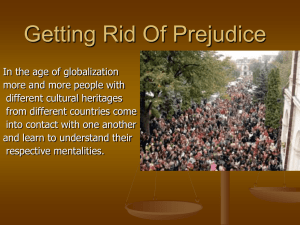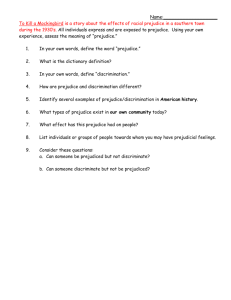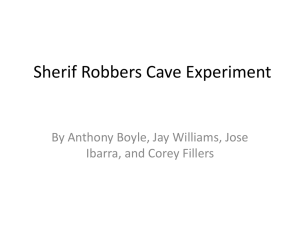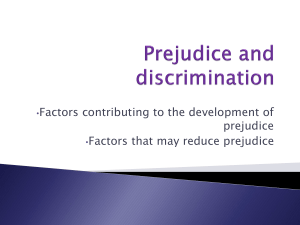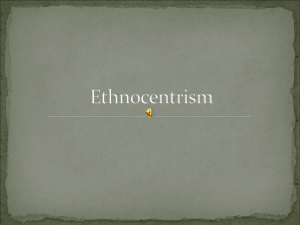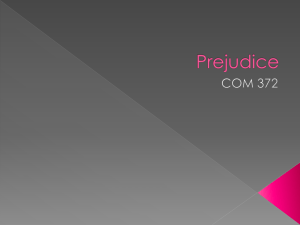Lecture 4: Other Conflict Theories
advertisement
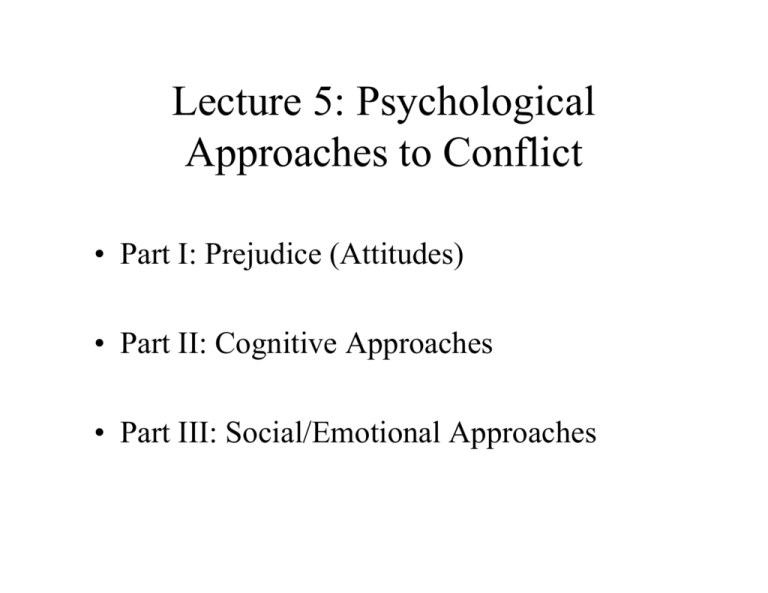
Lecture 5: Psychological Approaches to Conflict • Part I: Prejudice (Attitudes) • Part II: Cognitive Approaches • Part III: Social/Emotional Approaches Non-evolutionary Theories • Many pre-existing theories in many disciplines offer important insights about conflict and conflict resolution. These theories are not incompatible with evolutionary theory, and we can use these ideas to evaluate an integrated theory. • In the next few lectures we will review a few of these theories. Part I: Prejudice Prejudice is an attitude (usually negative) toward members of some group, based solely on their membership in that group. PREJUDICE Generalized attitude towards members of a group STEREOTYPE Generalized belief about members of a group DISCRIMINATION Behaviors directed towards people on the basis of their group membership • What are the characteristics of: • A typical New Yorker? • A typical white female? • A typical black male? • A typical Muslim? • Stereotype: generalized beliefs about members of a group that may or may not be accurate and might be positive or negative. • Do you know anyone who has, because of their membership in a group, been: • Denied a job or promotion? • Insulted or harassed? • Ignored or poorly served in a restaurant or business? • Denied an apartment or house? • Discrimination: negative behaviors directed at people based primarily on their group membership. AFFECT AFFECT (Feelings (Prejudice)) BEHAVIOR BEHAVIOR COGNITION (Actions you (Discrimination) (Stereotype) would take) How does Prejudice/Stereotypes lead to Conflict? • A conflict exists whenever two or more parties in interaction with each other are pursing goals that are perceived to be mutually incompatible or inconsistent, in the sense that it is impossible to simultaneously satisfy the goals pursued by all parties. How does Prejudice/Stereotypes lead to Conflict? • Perceiving members of a different group unfavorably (negative attitude) and/or holding certain beliefs about that group (stereotypes) can lead directly to conflict. • For example, these internal “beliefs” can make a person think that the difference between themselves and the other party is something incompatible that needs to be remedied. Hence, conflict can emerge. How does Prejudice/Stereotypes lead to Conflict? • In reality, prejudice attitudes and stereotypes interact with other forms of conflict such as competition for mates, jobs, status and resources. • I would argue that evolutionary theory needs to be integrated with the psychological processes discussed below. For example, male competition can be exacerbated or moderated depending on the level of prejudice. The Cultural Transmission of Prejudice • Cultural transmission is the transfer of information (culture) from one person to the next. • If individuals transmit prejudiced ideas, and stereotypes of other groups, group-level cultural differences can both emerge and be maintained. • Prejudice attitudes may be slow to change due to transmission from one generation to the next. Have prejudice attitudes changed? The results of numerous studies (Dovidio et al., 1996; Peterson, 1997) suggest that overt attitudes have changed dramatically over the past 60 years. Do you think homosexuals should or should not be hired for the following occupations? Percentage Saying “Should” 100 Salespersons 50 Doctors Clergy Elementary School Teachers Many still believe homosexuals should be excluded from some jobs – why? 0 1977 1982 1989 YEAR 1992 1996 (Herek, 2000) The pattern of change in attitudes in the US Interpretation • Attitudes sometimes change quite quickly. • There has been a sharp decline of views such as “There should be laws against intermarriage,” (though 10% to 20% of the white pop. still agrees with such items.) • But most of the change was completed by 1968. There has also been a decline in support for reducing existing racial and gender inequalities. • For example, the Civil Rights movement and the urban rebellions of the 1960’s seems to have driven a good deal of change, which stopped when that did. Can we trust self-reports? There are strong social norms against expressing prejudice overtly. This may lead to socially desirable responding on surveys that underestimates the levels of contemporary prejudice. • In sum, people may lie because they do not want to appear prejudiced to other people. Do People Hide their True Attitudes? Two treatment groups are formed to address this question. Both groups complete questionnaire about their attitudes concerning African Americans. Bogus pipeline group: – hooked up to machine via electrodes – told machine could “read minds” through physiological arousal Control group: – not hooked up to machine Bogus Pipeline Theoretical Prediction: • People lie on self-report questionnaires because of social desirability concerns Operational Prediction: • Negative attributes judged more characteristic of AA, and positive attributes less characteristic of AA under bogus pipeline condition Negative attributes judged more characteristic of African Americans under bogus pipeline condition Negative Attributes Bogus Pipeline Control Happy-go-lucky Ignorant Stupid Physically dirty Unreliable Lazy Aggressive -.13 .20 -1.00 -1.33 -.67 -.73 .67 .93 .60 .13 .20 .27 .60 1.20 Positive attributes judged less characteristic of African Americans under bogus pipeline condition Positive Attributes Intelligent Ambitious Sensitive Bogus Pipeline Control .00 .47 .07 .33 .87 1.60 Bogus Pipeline Conclusion: People lie on self-report measures to appear unprejudiced to others. Although people today self-report to be less prejudiced than people 20 or 50 years ago did, some of these differences may related to “social desirability”. Summary: Socialization and Attitude Change • Regardless of the fact that some people lie on self-reports to appear “socially correct”, prejudice attitudes have likely changed substantially in the U.S. • We will return to this topic later in the course when we talk about social dominance and racism. Part II: Cognitive Sources of Prejudice Prejudice is partially a byproduct of normal thinking processes. Schema and heuristics lead to informational shortcuts, but at some cost. Schemas about social groups—stereotypes— contains beliefs about members of an “outgroup” that may not always be true welfare recipient minister President of United States criminal African-American head of family musician excellent athlete straight A student Fortune 500 CEO entrepreneur Model of neural activation nodes, connections & social categories Categorization through Schema •BENEFITS: Reduces the amount of information to be dealt with and reduces the complexity of the social world. • COSTS: Leads people to underestimate the differences within groups, overestimate the differences between groups 1.) Perceived Similarities and Differences: Out-group homogeneity Effect and Own-race bias 2.) Distinctiveness (vivid cases, illusory correlations) Out-group Homogeneity Effect The assumption that members of an outgroup are “all the same.” When the group is our own we are more likely to see diversity. Out-groups (those outside our groups) are homogenized. Examples: a.) Europeans view of the Swiss b.) “Latinos” as one category c.) other sororities as less diverse Own Race Bias Brigham et al. (1982) had accomplices (either Black or White) enter a convenience store and make a purchase in a way sure to draw attention. Later, the experimenters, posing as law interns, asked the clerks (either Black or White) to identify the accomplice from a photo lineup of 6 Black and 6 White individuals. % Correct Identification 70 Black Accomplice 60 White Accomplice 50 40 30 20 10 0 Black Clerk White Clerk Illusory Correlations Illusory correlation: A false impression that two variables correlate. Occurs because negative behaviors and outgroup members are both distinct. This shared distinctiveness is more memorable that other combinations. Seeking Mental Efficiency Characteristics of Efficient Stereotypes • People use stereotypes because, although sometimes inaccurate, many contain a “kernel of truth”. • Example: even though people rarely mistake the direction of actual sex differences, they often overestimate their size. Seeking Mental Efficiency The Reality Females The Stereotype Males Less More Aggressiveness Females Males Less More Aggressiveness To save time and cognitive effort, we often sharpen distinctions between groups and soften differences within groups. Seeking Mental Efficiency Automatic Stereotype Activation • Hearing the neutral word “bread” automatically primes most people to think of the word “butter.” • Thus, even non-prejudiced people have automatic associations with general racial stereotypes that can be activated without their awareness. Seeking Mental Efficiency Automatic Activation: An Example • Most people make rapid decisions about words stereotypically associated with Blacks (e.g., “musical”, “athletic”). • They recognize these words more quickly if subliminally primed with the word “BLACK” beforehand. • However, they recognize words such as “educated” more quickly if subliminally primed with the word “WHITE”. Part III: Social/Emotional Sources of Prejudice • The next set of theories are psychological in that they emerged in psychology departments. • However, the theories incorporate macrolevel processes (e.g., identity), and thus also of interest to many sociologists. Social Identity Theory (SIT) Social identities made stronger by in-group and out-group distinctions. In-group: “Us”- a group of people who share a sense of belonging, a feeling of common identity Out-group: “Them”- a group that people perceives as distinctively different from or apart from their in-group. (SIT): Minimal Group Paradigm • Group identification sufficient to instigate intergroup conflict • Competition for scarce resources not necessary Minimal Group Paradigm • • • • • People assigned to groups Groups have no history, norms, or values Members have no contact Membership based on trivial criteria Task have minimal outcomes with respect to competition for real resources. Goal: Evaluate if group membership ALONE produces ingroup bias Experiment • Tajfel (1973) – High school boys in England – Study on “visual perception” • Estimate “dots” • Random assignment Individuals told that they are either in Over- or Underestimator group. • Divided into two ‘minimal’ groups (no history, no interaction) based on over or underestimators. Choices Concerning Money • Boys were show tables of numbers representing how much money (pennies) they could allocate to either in-group members or outgroup members. • They could not allocate money to themselves, and they did not know the individual identity of the boy who would receive the money—only the group that they were from. Experiment • The results demonstrated that when the boys had the choice between maximising the profit for all and maximising the profit for their own group, they chose the latter. Even more interestingly though, the boys were found to be more concerned with creating as large a difference as possible between the amounts allocated to each group (in favor of their own group), then in gaining a greater amount for everybody, across the two groups. Minimal Group Paradigm Major Finding: In-group bias occurred in absence of competition over scarce resources Group identity was sufficient to create in-group bias Realistic Group Conflict Theory One of the oldest explanations argues that prejudice arises from social competition over scarce resources. 1.) Realistic Group Conflict Theory Realistic Group Conflict Theory Central Assumptions 1. People are selfish and out for own gain 2. Incompatible group interests cause intergroup conflict 3. Incompatible group interests cause social psychological processes (e.g., in-group favoritism; stereotyping) Summary Competition between groups for scarce resources produces inter-group conflict.Without such competition, inter-group conflict would fade. Sherif and Colleagues: The Robbers Cave Experiments Purpose: understand conflict between groups to identify how intergroup relations can be more positive. Created three situations to foster 1.) group identity, 2.) inter-group conflict, and 3.) group harmony Sherif and Colleagues • • • • Participants 11-12 year old boys who signed up for a camp in Oklahoma Camp lasted 3 weeks Boys had similar backgrounds, no behavioral/psychological problems Boys were brought to camp in two separate group, and kept separate for the first few days at camp. Stage 1: Group Formation • Boys developed strong in-group identity – interacted with own group exclusively – activities fostered liking • 95% of listed friends from in-group • Each group, later to be called the Eagles and the Rattlers, conducted their own separate activities. The groups developed within-group identities. • Upon, learning about the other group, both groups became insistent that competitive sports be organized between them. Stage 2: Intergroup Conflict • The two in-groups set the stage for the friction phase of inter-group relations. • “Councilors” announced their would be a Tournament of Games: 5$ prize – – – – baseball touch football tug of war treasure hunt Stage 2: Intergroup Conflict The tournament led to increasing competition and animosity between the groups. Intergroup conflict: – name calling – stealing flags – fights CONFLICT: “You can tell those guys I did it if they say anything. I’ll fight ‘em!” Ongoing conflict led to the Eagles finally stealing the Rattlers flag and burning it. Stage 2: Intergroup Conflict Other data illustrated how prejudice and stereotypes developed among the two groups. 1.) Boys developed stereotypes favorable towards in-groups and unfavorable towards out-groups. Stage 3: Intergroup Harmony Experimenters tried to reduce intergroup conflict and ingroup bias Goals that could only be achieved if boys from both groups cooperated • water supply malfunctioned • bus broke down • Joint meals and cooking

